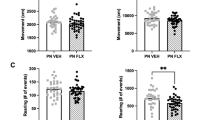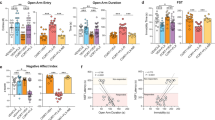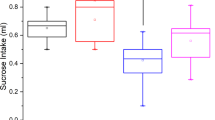Abstract
The onset of the therapeutic response to antidepressant treatment exhibits a characteristic delay. Animal models sensitive to chronic, but not acute, antidepressant treatment are greatly needed for studying antidepressant mechanisms. We initially assessed four inbred mouse strains for their behavioral response to chronic treatment with the selective-serotonin reuptake inhibitor fluoxetine (0, 5, 10 mg/kg/day in drinking water), which is used for the treatment of mood and anxiety disorders. Only the highly anxious BALB/c strain exhibited sensitivity to fluoxetine in the forced swim test. Additionally, fluoxetine reduced locomotion in C57BL/6 and 129SvEv, but not BALB/c and DBA/2, strains. We then evaluated the effects of subchronic (∼4 days) and chronic (∼24 days) fluoxetine treatment (0, 10, 18, 25 mg/kg/day) on measures of anxiety and depression in BALB/c mice. Anxiety measures were obtained using the open field and novelty-induced hypophagia tests. Antidepressant effects were evaluated using the forced swim test. We found 18 mg/kg/day of chronic fluoxetine to be active in all three paradigms; subchronic treatment had no effect. Anxiety-related measures were reduced by 18 mg/kg/day. In the forced swim test, 10 and 18 mg/kg/day increased swimming and reduced immobility. Here we present several novel effects of chronic, but not subchronic, antidepressant treatment.
Similar content being viewed by others
Log in or create a free account to read this content
Gain free access to this article, as well as selected content from this journal and more on nature.com
or
References
Alcaro A, Cabib S, Ventura R, Puglisi-Allegra S (2002). Genotype- and experience-dependent susceptibility to depressive-like responses in the forced-swimming test. Psychopharmacology (Berlin) 164: 138–143.
American Psychiatric Association (1994). Diagnostic and Statistical Manual of Mental Disorders, 4th Edn. American Psychiatric Association: Washington, DC.
Barr AM, Markou A, Phillips AG (2002). A ‘crash’ course on psychostimulant withdrawal as a model of depression. Trends Pharmacol Sci 23: 475–482.
Barr LC, Heninger GR, Goodman W, Charney DS, Price LH (1997). Effects of fluoxetine administration on mood response to tryptophan depletion in healthy subjects. Biol Psychiatry 41: 949–954.
Belzung C, Le Pape G (1994). Comparison of different behavioral test situations used in psychopharmacology for measurement of anxiety. Physiol Behav 56: 623–628.
Bilkei-Gorzo A, Racz I, Michel K, Zimmer A (2002). Diminished anxiety- and depression-related behaviors in mice with selective deletion of the Tac1 gene. J Neurosci 22: 10046–10052.
Blier P (2003). The pharmacology of putative early-onset antidepressant strategies. Eur Neuropsychopharmacol 13: 57–66.
Bodnoff SR, Suranyi-Cadotte B, Aitken DH, Quirion R, Meaney MJ (1988). The effects of chronic antidepressant treatment in an animal model of anxiety. Psychopharmacology (Berlin) 95: 298–302.
Borsini F, Lecci A, Sessarego A, Frassine R, Meli A (1989). Discovery of antidepressant activity by forced swimming test may depend on pre-exposure of rats to a stressful situation. Psychopharmacology (Berlin) 97: 183–188.
Borsini F, Podhorna J, Marazziti D (2002). Do animal models of anxiety predict anxiolytic-like effects of antidepressants? Psychopharmacology (Berlin) 163: 121–141.
Bourin M, Fiocco AJ, Clenet F (2001). How valuable are animal models in defining antidepressant activity? Hum Psychopharmacol 16: 9–21.
Bouwknecht JA, Paylor R (2002). Behavioral and physiological mouse assays for anxiety: a survey in nine mouse strains. Behav Brain Res 136: 489–501.
Caccia S, Cappi M, Fracasso C, Garattini S (1990). Influence of dose and route of administration on the kinetics of fluoxetine and its metabolite norfluoxetine in the rat. Psychopharmacology (Berlin) 100: 509–514.
Conti AC, Cryan JF, Dalvi A, Lucki I, Blendy JA (2002). cAMP response element-binding protein is essential for the upregulation of brain-derived neurotrophic factor transcription, but not the behavioral or endocrine responses to antidepressant drugs. J Neurosci 22: 3262–3268.
Cryan JF, Lucki I (2000). Antidepressant-like behavioral effects mediated by 5-Hydroxytryptamine(2C) receptors. J Pharmacol Exp Ther 295: 1120–1126.
Cryan JF, Markou A, Lucki I (2002a). Assessing antidepressant activity in rodents: recent developments and future needs. Trends Pharmacol Sci 23: 238–245.
Cryan JF, Page ME, Lucki I (2002b). Noradrenergic lesions differentially alter the antidepressant-like effects of reboxetine in a modified forced swim test. Eur J Pharmacol 436: 197–205.
D’Sa C, Duman RS (2002). Antidepressants and neuroplasticity. Bipolar Disord 4: 183–194.
Detke MJ, Johnson J, Lucki I (1997). Acute and chronic antidepressant drug treatment in the rat forced swimming test model of depression. Exp Clin Psychopharmacol 5: 107–112.
Detke MJ, Lucki I (1996). Detection of serotonergic and noradrenergic antidepressants in the rat forced swimming test: the effects of water depth. Behav Brain Res 73: 43–46.
Dulawa SC, Grandy DK, Low MJ, Paulus MP, Geyer MA (1999). Dopamine D4 receptor-knock-out mice exhibit reduced exploration of novel stimuli. J Neurosci 19: 9550–9556.
Gelfin Y, Gorfine M, Lerer B (1998). Effect of clinical doses of fluoxetine on psychological variables in healthy volunteers. Am J Psychiatry 155: 290–292.
Geyer M, Markou A (1995). Animal models of psychiatric disorders. In: Bloom F, Kupfer D (eds). Psychopharmacology: The Fourth Generation of Progress. Raven Press: New York. pp 787–798.
Geyer M, Markou A (2002). The role of preclinical models in the development of psychotropic drugs. In: Davis K, Charney D, Coyle J, Nemeroff C (eds). Neuropsychopharmacology: The Fifth Generation of Progress. Lippincott Williams & Wilkins: Philadelphia. pp 446–455.
Griebel G, Belzung C, Perrault G, Sanger DJ (2000). Differences in anxiety-related behaviours and in sensitivity to diazepam in inbred and outbred strains of mice. Psychopharmacology (Berlin) 148: 164–170.
Hiemke C, Hartter S (2000). Pharmacokinetics of selective serotonin reuptake inhibitors. Pharmacol Ther 85: 11–28.
Hirschfeld R, Weisssman M (2002). Risk factors for major depression and bipolar disorder. In: Davis K, Charney D, Coyle J, Nemeroff C (eds). Neuropsychopharmacology: The Fifth Generation of Progress. Lippincott Williams & Wilkins: Philadelphia. pp 1018–1025.
Karolewicz B, Paul IA (2001). Group housing of mice increases immobility and antidepressant sensitivity in the forced swim and tail suspension tests. Eur J Pharmacol 415: 197–201.
Kelliher P, Kelly JP, Leonard BE, Sanchez C (2003). Effects of acute and chronic administration of selective monoamine re-uptake inhibitors in the rat forced swim test. Psychoneuroendocrinology 28: 332–347.
Kim S, Lee S, Ryu S, Suk J, Park C (2002). Comparative analysis of the anxiety-related behaviors in four inbred mice. Behav Processes 60: 181–190.
Kokkinidis L, Zacharko RM, Predy PA (1980). Post-amphetamine depression of self-stimulation responding from the substantia nigra: reversal by tricyclic antidepressants. Pharmacol Biochem Behav 13: 379–383.
Kopp C, Vogel E, Rettori MC, Delagrange P, Guardiola-Lemaitre B, Misslin R (1999). Effects of melatonin on neophobic responses in different strains of mice. Pharmacol Biochem Behav 63: 521–526.
Koran LM, Cain JW, Dominguez RA, Rush AJ, Thiemann S (1996). Are fluoxetine plasma levels related to outcome in obsessive-compulsive disorder? Am J Psychiatry 153: 1450–1454.
Le Pen G, Gaudet L, Mortas P, Mory R, Moreau JL (2002). Deficits in reward sensitivity in a neurodevelopmental rat model of schizophrenia. Psychopharmacology (Berlin) 161: 434–441.
Lucki I, Dalvi A, Mayorga AJ (2001). Sensitivity to the effects of pharmacologically selective antidepressants in different strains of mice. Psychopharmacology (Berlin) 155: 315–322.
Markou A, Hauger RL, Koob GF (1992). Desmethylimipramine attenuates cocaine withdrawal in rats. Psychopharmacology (Berlin) 109: 305–314.
Merali Z, Levac C, Anisman H (2003). Validation of a simple, ethologically relevant paradigm for assessing anxiety in mice. Biol Psychiatry 54: 552–565.
Merikangas K, Pine D (2002). Genetic and other vulnerability factors for anxiety and stress disorders. In: Davis K, Charney D, Coyle J, Nemeroff C (eds). Neuropsychopharmacology: The Fifth Generation of Progress. Lippincott Williams & Wilkins: Philadelphia. pp 868–882.
Moreau JL, Jenck F, Martin JR, Mortas P, Haefely WE (1992). Antidepressant treatment prevents chronic unpredictable mild stress-induced anhedonia as assessed by ventral tegmentum self-stimulation behavior in rats. Eur Neuropsychopharmacol 2: 43–49.
Ohl F, Roedel A, Binder E, Holsboer F (2003). Impact of high and low anxiety on cognitive performance in a modified hole board test in C57BL/6 and DBA/2 mice. Eur J Neurosci 17: 128–136.
Porsolt RD, Bertin A, Jalfre M (1977). Behavioral despair in mice: a primary screening test for antidepressants. Arch Int Pharmacodyn Ther 229: 327–336.
Prut L, Belzung C (2003). The open field as a paradigm to measure the effects of drugs on anxiety-like behaviors: a review. Eur J Pharmacol 463: 3–33.
Reneric JP, Bouvard M, Stinus L (2002). In the rat forced swimming test, chronic but not subacute administration of dual 5-HT/NA antidepressant treatments may produce greater effects than selective drugs. Behav Brain Res 136: 521–532.
Santarelli L, Saxe M, Gross C, Surget A, Battaglia F, Dulawa S et al (2003). Requirement of hippocampal neurogenesis for the behavioral effects of antidepressants. Science 301: 805–809.
Shephard RA, Broadhurst PL (1982). Hyponeophagia and arousal in rats: effects of diazepam, 5-methoxy-N,N-dimethyltryptamine, d-amphetamine and food deprivation. Psychopharmacology (Berlin) 78: 368–372.
Suckow RF, Zhang MF, Cooper TB (1992). Sensitive and selective liquid-chromatographic assay of fluoxetine and norfluoxetine in plasma with fluorescence detection after precolumn derivatization. Clin Chem 38: 1756–1761.
Tang X, Orchard SM, Sanford LD (2002). Home cage activity and behavioral performance in inbred and hybrid mice. Behav Brain Res 136: 555–569.
Thompson MR, Li KM, Clemens KJ, Gurtman CG, Hunt GE, Cornish JL et al (2003). Chronic fluoxetine treatment partly attenuates the long-term anxiety and depressive symptoms induced by MDMA (‘Ecstasy’) in rats. Neuropsychopharmacology, doi: 10.1038/sj.npp.1300347.
Welker W (1957). ‘Free’ versus ‘forced’ exploration of a novel situation by rats. Psychol Rep 3: 95–108.
Willner P (1997). Validity, reliability and utility of the chronic mild stress model of depression: a 10-year review and evaluation. Psychopharmacology (Berlin) 134: 319–329.
Yilmazer-Hanke DM, Roskoden T, Zilles K, Schwegler H (2003). Anxiety-related behavior and densities of glutamate, GABAA, acetylcholine and serotonin receptors in the amygdala of seven inbred mouse strains. Behav Brain Res 145: 145–159.
Acknowledgements
This work was supported by the National Institute on Drug Abuse (R01 DA09862), the National Institute of Mental Health (R01 MH068542-1), (P50 MH50733), and the National Alliance for Research on Schizophrenia and Depression (NARSAD). SC Dulawa was supported by an individual postdoctoral National Research Service Award (F32-MH65791-01A1).
Author information
Authors and Affiliations
Corresponding author
Rights and permissions
About this article
Cite this article
Dulawa, S., Holick, K., Gundersen, B. et al. Effects of Chronic Fluoxetine in Animal Models of Anxiety and Depression. Neuropsychopharmacol 29, 1321–1330 (2004). https://doi.org/10.1038/sj.npp.1300433
Received:
Revised:
Accepted:
Published:
Issue date:
DOI: https://doi.org/10.1038/sj.npp.1300433
Keywords
This article is cited by
-
Hyperactivity of indirect pathway-projecting spiny projection neurons promotes compulsive behavior
Nature Communications (2024)
-
Modulation of serotonin transporter expression by escitalopram under inflammation
Communications Biology (2024)
-
Diosgenin alleviates alcohol-mediated escalation of social defeat stress and the neurobiological sequalae
Psychopharmacology (2024)
-
Serotonin regulation of behavior via large-scale neuromodulation of serotonin receptor networks
Nature Neuroscience (2023)
-
The Serotonergic System and Bone Metabolism During Pregnancy and Lactation and the Implications of SSRI Use on the Maternal-Offspring Dyad
Journal of Mammary Gland Biology and Neoplasia (2023)



